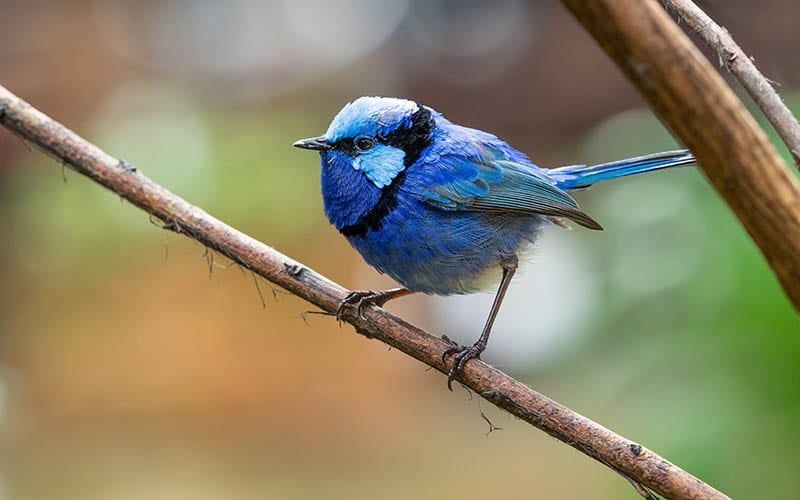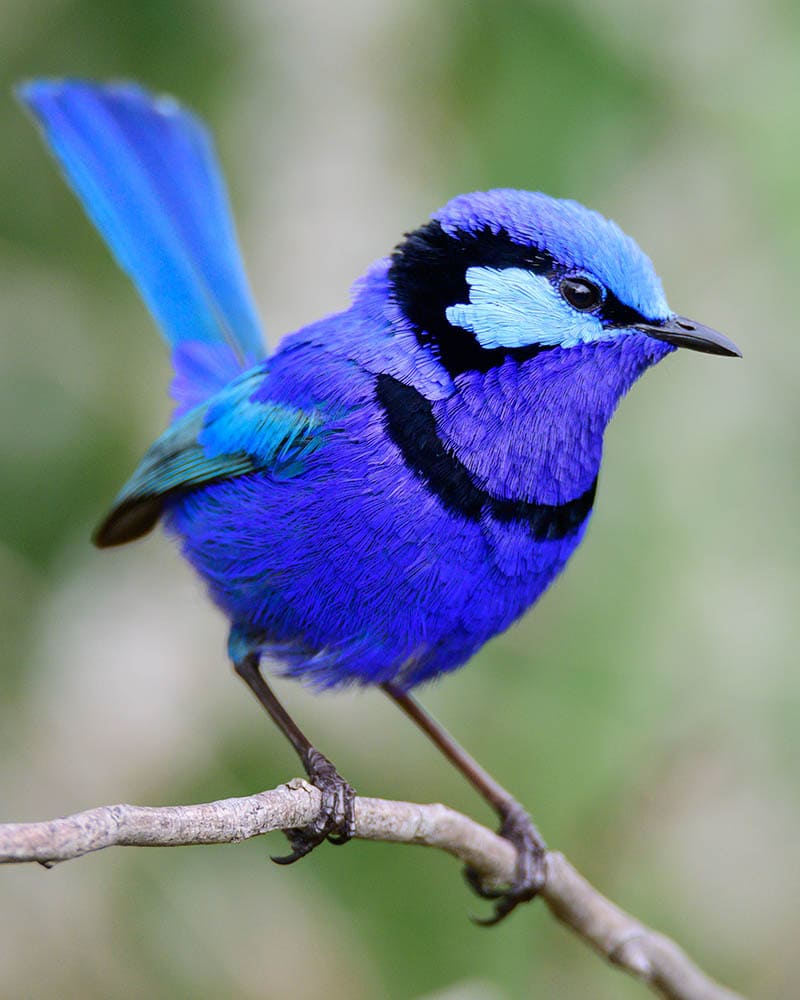Splendid Fairywren: Field Guide, Pictures, Habitat & Info
Last Updated on

Blue birds are very attractive. We cannot think about anything that’s not aesthetically pleasing about them, especially when it comes to the feather colorations. What’s more, some of them have the ability to sing songs that are melodious and hypnotizing. The Splendid Fairy is one of them.
Read on below to learn all about the beautiful Splendid Fairywren.

Quick Facts About the Splendid Fairywren
| Habitat: | Dry, Shrubby |
| Diet | Insects, Seeds, Fruits |
| Behavior | Territorial |
| Nesting | Ground-Nesting |
| Conservation | Least Concern |
| Scientific name: | Malurus splendens |
| Lifespan: | 5–6 years |
Splendid Fairywren General Description
The Splendid Fairywren is a small, long-tailed passerine species, and a member of the Australasian wren family. Some people simply call it the Blue Wren because it’s predominantly blue.
They normally exhibit sexual dimorphism, as the male plumage is very different from that of the female or the juveniles. Furthermore, they are divided into four subspecies: The Black-Backed Fairywren, M.S. Emmottorum, Banded Fairywren, and Turquoise Fairywren.

Splendid Fairywren: Range, Habitat, Behavior, Diet & Nesting
Range & Habitat
If you’d like to dine and wine with this species, you’ll have to travel to Australia. Of course, some of them can be found here in various zoos, but they were all brought in from “The Land Down Under.” While you’re there, look for them in New South Wales, Queensland, or in the coastal western regions.
From our understanding, they prefer living within the arid and semi-arid zones of that country. Their habitats are typically described as dry and shrubby, where you’ll find the mallee (it’s a low-growing shrubby eucalyptus) and mulga (shrub with grayish foliage). The Black-backed Fairy Wren and the Banded Blue Wren subspecies are both considered sedentary in nature.
A sedentary species is one that lives in a particular region for a significantly long period of time before moving. Conversely, the Turquoise subspecies are partially migratory. One significant similarity that we observed while studying all the subspecies is that they don’t adapt that well to human encroachment.
In fact, it’s the reason why they keep moving anytime we start setting up buildings, utilities, and other developments close to their habitats. They also try to stay away from pine forest plantations and other habitats that lack undergrowth.
Behavior
The Splendid Fairywren is one of those species that are active and restless when it comes to feeding. And they’ll be having the time of their lives, should they get the opportunity to feed on an open ground that’s mostly covered by a shade, or in some healthy green foliage. Their tails are always upright and still for a reason—to give them the right balance as they bounce or hop from one point to the next.
Whilst the Splendid is the strongest flier in the Fairywren family, its wings were not designed for extended jaunts. So don’t expect to find them soaring in the skies, competing with birds that spend a considerable amount of time flying.
This bird understands all too well just how important it is to defend a territory. You’ll never find a situation whereby all the Splendid Fairywrens have decided to migrate to a different region, without leaving anyone behind. Even if the weather conditions are too extreme for their survival, you’ll still find two to eight Fairywrens left behind, holding down the fort.
The size of that territory will depend on the total number of males in that community and the vegetation density. A community will comprise of “socially monogamous” pairs and helper birds. The phrase “socially monogamous” is used because, in this context, it doesn’t mean that they are only sexually active with one partner.
It means that they’ll spend most of their time with a partner, but sneak out once in a while, to sexually interact with other mates. And this is an observation that has been made while studying the behavioral tendencies of both the male and female Fairywren. So, in essence, it’s okay to assume that they are all somewhat promiscuous.
The chores assigned to the helpers are to assist the alphas and betas in defending the territory, feeding the younglings, and rearing them. They’ll do that until they are sexually mature enough to seek mates and start their own families.
Cats and the red foxes are thought to be the chief predators in this ecosystem. And they often prey on the nests, instead of the adults. When a Splendid Fairywren spots one coming, they’ll try to lead them away by utilizing the rodent-run technique. This is a distraction display that’s normally performed by nearly all ground-nesting species when an intruder shows up in the form of a predator.

Diet
We’d classify the Splendid Fairywrens as insectivores, seeing as they always go for insects even when there’s an abundance of other foods. We’ve seen them hunt bugs, crickets, ants, spiders, etc. The only time they’ll eat fruits, nectar, or seeds, is when they feel the need to supplement their protein-rich diets with vitamins or other minerals.
While foraging, they’ll practice what’s called “hop-searching.” Like rabbits, they’ll hop from one shrub to the next, looking for food. The species like to forage in groups, hoping the strength in numbers will give them the edge they need to fight off predators looking to make a meal out of them.
The young are not usually fed the same items that the adults are eating. If say, ants are the main delicacy, the younglings will have grasshoppers or caterpillars.
Nesting
The Splendid Fairywren family breeding timetable starts in late August and runs through to early January. However, with the changing weather and climatic conditions, they never know when exactly the best time is to start building nests. Sometimes they start too early, only for the heavy rains to come and sweep all their hard work away.
It’s the female’s responsibility to ensure the nest is ready. They often use spider webs and soft grasses as the main construction materials for the interior, and a small quantity of thorny vegetation to cover the exterior and entrance. The entire structure is usually domed-shaped, and comfortable enough to accommodate two broods. Yes, they sometimes lay two broods per season.
A clutch will have two to four eggs. They’ll be incubated for roughly 2 weeks before they start hatching. Once hatched, the chicks will be fed by the helpers, who’ll also be tasked with removing their fecal sacs. They’ll be fully fledged after 2 weeks, but still be part of that group for close to a year.
During that period, they’ll join the helper group. And when the time comes, they’ll either move to a different group, start their own group, or assume a more dominant position in the one they were born in. Either way, they always get the promotion to a higher level.

How to Find Splendid Fairywrens: Birdwatching Tips
What to Listen For
This species has several vocalizations, but there’s a primary call that’s often produced by a breeding pair, throughout a season. Ostensibly, the purpose of the call is to let the other members of the community know that they need to stay vigilant, to ensure their territory is well protected. This call can be described as high-pitched pips that are slightly metallic.
What to Look For
The males are much more colorful than their spouses. They have a bright blue plumage covering most of their bodies, and velvet-blue feathers covering their breasts. The other conspicuous feature is the black stripe that sort of looks like a ring worn around the breasts, extending to the eyes.
When they are not breeding, all that plumage brightness goes away. It’s a little bit dull, just like the female, but doesn’t take on the brownish shades usually seen on the upper parts of the ladies. They have a wingspan of about 14 inches, are 6 inches long, and weigh approximately 0.4 ounces.
When to Look
The best time to look for these birds is the period between dawn and 11 am. That’s when they are most active, as they will be busy foraging for food. Remember, the Splendid Fairywren is a diurnal creature. It goes to sleep when the sun sets and wakes up when it rises. Without that light, it cannot hunt for insects or forage on the ground.

Attracting Splendid Fairywrens to Your Backyard: Tips & Tricks
If you want to lure the Splendid Fairywren to your yard, you need to get acquainted with what they like and what they don’t like. At this point, we know they love eating insects and safe foraging sites.
- If you can, plant spiny ground covers.
- Install feeders and fill them with sunflower seeds.
- Find a way to make your yard an insect hub.
- Install water baths.
- Pets: Especially cats because they view cats as apex predators.
- Open spaces: They don’t like feeling exposed or vulnerable to unforeseen attacks.
- Pesticides: This will deal with your insect infestation problem, but eventually affect the bird after they feed on the dead insects.
- Over-pruning plants: They need that shelter to hide from predators.
Conservation: Is This Bird Threatened?
What’s the biggest threat to their population? Deforestation. It’s the leading cause of their habitat loss and the main reason why it’s now easy for predators to hunt them down. By the way, they are normally hunted by several predatory species, including the black rat, Australian magpies, ravens, butcherbirds, etc.
As per the records obtained from the International Union for Conservation of Nature, this species is still very common in their native homes, and widespread within its range. There have been no alarming signs at the moment to classify them as “threatened” or “near-threatened.” Hence the reason why they’ve been tagged “least concern.”

Final Thoughts
The important takeaways from this article are that the Splendid Fairywren is cute, only common in Australia, small, socially monogamous, sexually promiscuous, and harmless to humans. They also have a very short lifespan, and their habitats are threatened by deforestation. So, if you can, help spread this message and save future generations.
Featured Image Credit: David Steele, Shutterstock
Table of Contents
- Quick Facts About the Splendid Fairywren
- Splendid Fairywren General Description
- Splendid Fairywren: Range, Habitat, Behavior, Diet & Nesting
- How to Find Splendid Fairywrens: Birdwatching Tips
- Attracting Splendid Fairywrens to Your Backyard: Tips & Tricks
- Conservation: Is This Bird Threatened?
- Final Thoughts
About the Author Robert Sparks
Robert’s obsession with all things optical started early in life, when his optician father would bring home prototypes for Robert to play with. Nowadays, Robert is dedicated to helping others find the right optics for their needs. His hobbies include astronomy, astrophysics, and model building. Originally from Newark, NJ, he resides in Santa Fe, New Mexico, where the nighttime skies are filled with glittering stars.
Related Articles:
10 Types of Hummingbirds in Arkansas (With Pictures)
8 Types of Hummingbirds in Nebraska (With Pictures)
5 Types of Hummingbirds in Idaho (With Pictures)
3 Types of Hummingbirds in Mississippi (With Pictures)
8 Types of Hummingbirds in Kansas (With Pictures)
5 Types of Hummingbirds in West Virginia (With Pictures)
5 Types of Hummingbirds in Ohio (With Pictures)
Where Do Nuthatches Nest? Nuthatch Nesting Habits Explained
